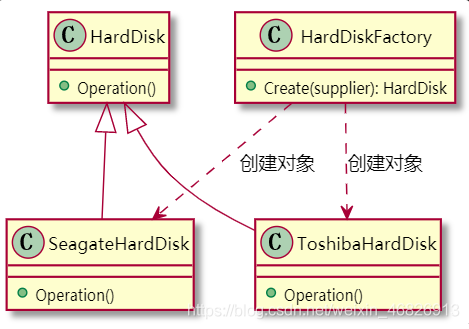1、简介
简单工厂方法定义一个用于创建对象的类,该类接受一个参数,通过参数决定创建不同的对象。
GOF并没有把简单工厂方法定义为23种设计模式之一,可以认为简单工厂方法是工厂方法的简化形式。
为了体现简单工厂方法和工厂方法的区别和联系,此处把简单工厂方法先单独讲一下。
2、模拟场景
假设你要生产电脑,电脑由硬盘、内存条、CPU、主板的部件组成。你为了保证供应链可靠,每种部件都选择了至少两家供应商。比如:
硬盘供应商 seagate、Toshiba
内存条供应商 SAMSUNG、Crucial
主板供应商 intel、AMD
此处列出多个部件是为了后面讲解工厂方法、抽象工厂方法时使用同一个模拟场景。本章讲简单工厂方法暂时不需要涉及这么多部件,所以仅以硬盘这一个部件为例进行讲解。
3、实现的思路
硬盘就是要创建的对象(即:产品)。为了让不同供应商提供的硬盘可以通用,要定义一个硬盘产品类,并让不同供应商的硬盘都继承硬盘产品类的接口。
还需要定义一个创建硬盘对象的类(即:工厂)。工厂类根据参数决定创建哪家供应商的硬盘对象。
4、实现硬盘对象创建
参与者:
(1)Product: HardDisk 定义硬盘对象的接口
(2)Concrete Product: SeagateHardDisk, ToshibaHardDisk 实现不同供应商的硬盘
(3)SimpleFactory: HardDiskFactory 根据参数,创建不同供应商的硬盘对象
UML:

HardDisk代码示例:
hard_disk.h:
#ifndefHARD_DISK_H
#defineHARD_DISK_H
structHardDisk{
void(*Operation)(structHardDisk*this);
};
#endif
SeagateHardDisk代码示例:
seagate_hard_disk.h:
#ifndefSEAGATE_HARD_DISK_H
#defineSEAGATE_HARD_DISK_H
#include"hard_disk.h"
structSeagateHardDisk{
structHardDiskhardDisk;
};
//构造函数
voidSeagateHardDisk(structSeagateHardDisk*this);
//析构函数
void_SeagateHardDisk(structSeagateHardDisk*this);
#endif
seagate_hard_disk.c:
#include"seagate_hard_disk.h"
#include"stdio.h"
voidSeagateOperation(structSeagateHardDisk*this)
{
printf("这是Seagate硬盘
");
}
voidSeagateHardDisk(structSeagateHardDisk*this)
{
this->hardDisk.Operation=(void(*)(structHardDisk*))SeagateOperation;
}
void_SeagateHardDisk(structSeagateHardDisk*this)
{
this->hardDisk.Operation=NULL;
}
ToshibaHardDisk代码示例:
toshiba_hard_disk.h:
#ifndefTOSHIBA_HARD_DISK_H
#defineTOSHIBA_HARD_DISK_H
#include"hard_disk.h"
structToshibaHardDisk{
structHardDiskhardDisk;
};
//构造函数
voidToshibaHardDisk(structToshibaHardDisk*this);
//析构函数
void_ToshibaHardDisk(structToshibaHardDisk*this);
#endif
toshiba_hard_disk.c:
#include"toshiba_hard_disk.h"
#include"stdio.h"
voidToshibaOperation(structToshibaHardDisk*this)
{
printf("这是Toshiba硬盘
");
}
voidToshibaHardDisk(structToshibaHardDisk*this)
{
this->hardDisk.Operation=(void(*)(structHardDisk*))ToshibaOperation;
}
void_ToshibaHardDisk(structToshibaHardDisk*this)
{
this->hardDisk.Operation=NULL;
}
HardDiskFactory代码示例:
hard_disk_factory.h:
#ifndefHARD_DISK_FACTORY_H
#defineHARD_DISK_FACTORY_H
#include"hard_disk.h"
enumHARD_DISK_SUPPLIER_E{
HARD_DISK_SUPPLIER_SEAGATE,
HARD_DISK_SUPPLIER_TOSHIBA
};
structHardDiskFactory{
structHardDisk*(*Create)(structHardDiskFactory*this,
enumHARD_DISK_SUPPLIER_Esupplier);
void(*Destroy)(structHardDiskFactory*this,
structHardDisk*hardDisk);
};
//构造函数
voidHardDiskFactory(structHardDiskFactory*this);
//析构函数
void_HardDiskFactory(structHardDiskFactory*this);
#endif
hard_disk_factory.c:
#include"hard_disk_factory.h"
#include"seagate_hard_disk.h"
#include"toshiba_hard_disk.h"
#include"stdio.h"
#include"stdlib.h"
structHardDisk*Create(structHardDiskFactory*this,
enumHARD_DISK_SUPPLIER_Esupplier)
{
switch(supplier){
caseHARD_DISK_SUPPLIER_SEAGATE:
{
structSeagateHardDisk*seagateHardDisk=NULL;
if((seagateHardDisk=malloc(sizeof(structSeagateHardDisk)))==NULL){
printf("failinmalloc
");
returnNULL;
}
SeagateHardDisk(seagateHardDisk);
return(structHardDisk*)seagateHardDisk;
}
caseHARD_DISK_SUPPLIER_TOSHIBA:
{
structToshibaHardDisk*toshibaHardDisk=NULL;
if((toshibaHardDisk=malloc(sizeof(structToshibaHardDisk)))==NULL){
printf("failinmalloc
");
returnNULL;
}
ToshibaHardDisk(toshibaHardDisk);
return(structHardDisk*)toshibaHardDisk;
}
default:
printf("未知的供应商
");
returnNULL;
}
}
voidDestroy(structHardDiskFactory*this,structHardDisk*hardDisk)
{
if(hardDisk!=NULL){
free(hardDisk);
}
}
//构造函数
voidHardDiskFactory(structHardDiskFactory*this)
{
this->Create=Create;
this->Destroy=Destroy;
}
//析构函数
void_HardDiskFactory(structHardDiskFactory*this)
{
this->Create=NULL;
this->Destroy=NULL;
}
客户端代码示例:
#include"hard_disk.h"
#include"hard_disk_factory.h"
#include"stddef.h"
voidmain()
{
structHardDisk*hardDisk=NULL;
structHardDiskFactoryhardDiskFactory;
HardDiskFactory(&hardDiskFactory);
//创建seagate硬盘对象
hardDisk=hardDiskFactory.Create(&hardDiskFactory,HARD_DISK_SUPPLIER_SEAGATE);
//使用seagate硬盘对象
hardDisk->Operation(hardDisk);
//销毁seagate硬盘对象
hardDiskFactory.Destroy(&hardDiskFactory,hardDisk);
//创建toshiba硬盘对象
hardDisk=hardDiskFactory.Create(&hardDiskFactory,HARD_DISK_SUPPLIER_TOSHIBA);
//使用seagate硬盘对象
hardDisk->Operation(hardDisk);
//销毁toshiba硬盘对象
hardDiskFactory.Destroy(&hardDiskFactory,hardDisk);
_HardDiskFactory(&hardDiskFactory);
}
客户端显示示例:
./hard_disk
这是Seagate硬盘
这是Toshiba硬盘
-
硬盘
+关注
关注
3文章
1327浏览量
57655 -
对象
+关注
关注
1文章
38浏览量
17435
原文标题:C语言 | 简单工厂方法模式实现例子
文章出处:【微信号:FANYPCB,微信公众号:凡亿PCB】欢迎添加关注!文章转载请注明出处。
发布评论请先 登录
相关推荐




 使用简单工厂方法实现硬盘对象创建
使用简单工厂方法实现硬盘对象创建













评论